

Genius Companies in New Media. The de Bono Group - Six Thinking Hats. Used with well-defined and explicit Return On Investment success in corporations worldwide, Six Thinking Hats is a simple, effective parallel thinking process that helps people be more productive, focused, and mindfully involved.
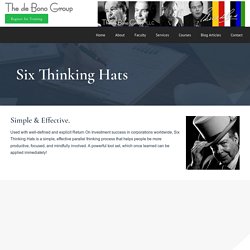
A powerful tool set, which once learned can be applied immediately! You and your team members can learn how to separate thinking into six clear functions and roles. Each thinking role is identified with a colored symbolic "thinking hat. " By mentally wearing and switching "hats," you can easily focus or redirect thoughts, the conversation, or the meeting. Using Six Thinking Hats®, you and your team will learn how to use a disciplined process which will...
Significant Applications for the Parallel Thinking Process of Six Thinking Hats Introducing The de Bono Group Leader's Package Two highly engaging de Bono Group resources bundled together for optimized team learning Read more about Six Hats Online Here Click here for Return on Investment results! How Do Good Causes Achieve Great Design? In my last post, I made a case for why design matters to good causes.
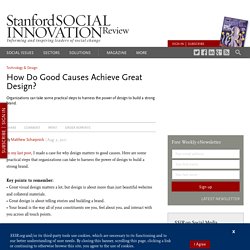
Here are some practical steps that organizations can take to harness the power of design to build a strong brand. Key points to remember: • Great visual design matters a lot, but design is about more than just beautiful websites and collateral materials. • Great design is about telling stories and building a brand. • Your brand is the way all of your constituents see you, feel about you, and interact with you across all touch points. So how does an organization with limited resources build a strong brand and support it with great design? Asking questions is a great place to start. Answers to the right questions shine a light on assumptions about an organization’s identity. . • What is the purpose of our organization? Keep in mind that these are not the only questions that matter, nor are they phrased in some sort of magical way.
. • Who is the audience for this method of communication? Finally, hire professionals. Why Wellbeing Programs Fail. Despite your best intentions and efforts are your wellbeing programs falling short of the long-term outcomes you hoped to achieve?
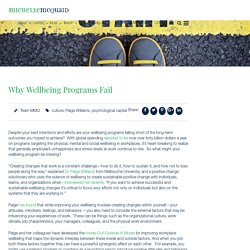
With global spending reported to be now over forty billion dollars a year on programs targeting the physical, mental and social wellbeing in workplaces, it’s heart-breaking to realize that generally employee’s unhappiness and stress levels at work continue to rise. So what might your wellbeing program be missing? Twitter tips, tools, and best practices. Meet the doughnut: the new economic model that could help end inequality. They say a picture speaks a thousand words, so here’s the state of humanity in a single image.
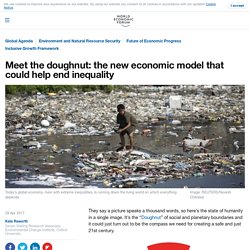
It’s the “Doughnut” of social and planetary boundaries and it could just turn out to be the compass we need for creating a safe and just 21st century. Image: Kate Raworth and Christian Guthier/The Lancet Planetary Health The hole at the Doughnut’s centre reveals the proportion of people worldwide falling short on life’s essentials, such as food, water, healthcare and political freedom of expression – and a big part of humanity’s challenge is to get everyone out of that hole. At the same time, however, we cannot afford to be overshooting the Doughnut’s outer crust if we are to safeguard Earth’s life-giving systems, such as a stable climate, healthy oceans and a protective ozone layer, on which all our wellbeing fundamentally depends.
Safe and just space What economic mindset can give us even half a chance of turning this situation around? Progress for everyone So much for Kuznets’ caveats. Share. Kate Raworth. Humanity’s 21st century challenge is to meet the needs of all within the means of the planet.

In other words, to ensure that no one falls short on life’s essentials (from food and housing to healthcare and political voice), while ensuring that collectively we do not overshoot our pressure on Earth’s life-supporting systems, on which we fundamentally depend – such as a stable climate, fertile soils, and a protective ozone layer. The Doughnut of social and planetary boundaries is a playfully serious approach to framing that challenge, and it acts as a compass for human progress this century. The Doughnut of social and planetary boundaries (2017) The environmental ceiling consists of nine planetary boundaries, as set out by Rockstrom et al, beyond which lie unacceptable environmental degradation and potential tipping points in Earth systems. Here’s a one-minute introduction to the Doughnut, by the brilliant animator Jonny Lawrence. Commentaries on the first doughnut of 2012.
Leader-Member Exchange (LMX) Theory. Explanations > Theories > Leader-Member Exchange (LMX) Theory Description | So What?
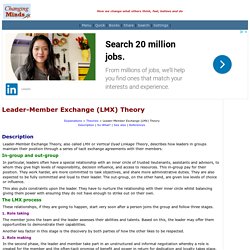
| See also | References Description Leader-Member Exchange Theory, also called LMX or Vertical Dyad Linkage Theory, describes how leaders in groups maintain their position through a series of tacit exchange agreements with their members. In-group and out-group. 5 Ways To Give (Thoughtful) Thanks To Your Team. A simple “thank you” can truly go a long way.

Whether it’s around the boardroom table, in a Slack channel, or privately outside the workplace, the act of showing gratitude can lift the spirits of anyone receiving some positive praise. As a leader or manager, showing gratitude for your team is particularly important. As you close out an exciting week, quarter, or year with your team, you hopefully feel #blessed 🙏🏻 for the hard work they put in every day. But how, and how often, are you thanking them for their effort? Expressing and receiving gratitude, especially in the workplace, is tied to increased productivity and efficiency. Learn these five ways to give thanks to your team and how a culture of gratitude can positively influence your workplace culture.
Why You Should Have An Attitude Of Gratitude As a leader, one of your main responsibilities is to empower your team to do their best work. Gratitude is also effective beyond the individual level. Escapades. Skillsets. Edgy. Intelligences Ensemble. Peopled Experiences. Socio.Logical. Systemic. Govern.Mental. US.A.ID. More or less.